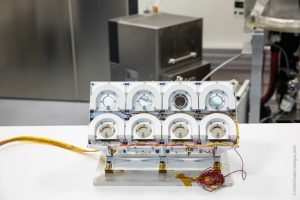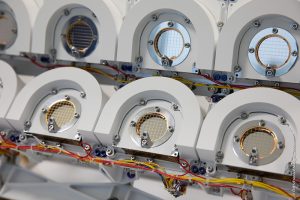An instrument from Toulouse will analyze a gas on the Moon’s surface in 2024
At a press briefing on Wednesday June 28, the DORN instrument was presented by those involved in the project, including Pierre-Yves Meslin, a teacher-researcher at the university and the instrument’s scientific manager. DORN will soon be sent to the Chinese space agency and will be on board the next Chang’e 6 lunar mission, scheduled for May 2024.
DORN (Detection of Outgassing RadoN) is an instrument designed and proposed by Pierre-Yves Meslin, a teacher-researcher at Toulouse III – Paul Sabatier University, scientific leader and specialist in radon in planetary environments, whether on Earth, Mars or Mercury, based at the Institut de recherche en astrophysique et planétologie (IRAP/OMP – CNES, CNRS, UT3). The DORN instrument is being developed and built at IRAP in Toulouse, under CNES contract management. DORN will be delivered to the Chinese Space Agency (CNSA) in July 2023.
It will be integrated on the lander of the Chang’e 6 lunar mission. DORN will remain on the lunar surface for a maximum operating time of 2 Earth days, just before lift-off of the sample return module.
DORN is dedicated to the measurement of radon, a radioactive gas continuously produced in the lunar soil, the so-called regolith, by the decay of uranium. For the first time, it will measure the concentration of radon present on the Moon’s surface, enabling us to study the origin of the lunar atmosphere (called the exosphere), by looking at its outgassing, and to study the transport of gases in this environment – a very fragile environment that will be rapidly disturbed by future missions. It will also improve uranium measurements from lunar orbit, and provide a better understanding of lunar dust transport.
This is the first time that a lunar mission has been tasked with bringing back a sample from the far side of the Moon. DORN, on the other hand, will remain on the Moon, so it’s a one-way ticket for it.
Pierre-Yves Meslin
DORN instrument identity card
Weight: 4.5 kg
Dimensions: 25 cm x 27 cm x 42 cm
Equipment: alpha spectrometer with 16 silicon detectors and pulse acquisition and processing electronics
Delivery to CNSA: July 2023
Scientific manager: Pierre-Yves Meslin
Technical manager: King Wah Wong
The Moon has an extremely thin “atmosphere” known as the exosphere. This exosphere has a short lifespan, due to its interaction with UV radiation and the solar wind, which rapidly expel it. This also means that it is constantly being regenerated. It has three possible sources:
- the solar wind (which brings hydrogen, helium, argon, carbon, nitrogen, etc.) and interactions between the solar radiation and the lunar surface (sodium, potassium, water, methane, CO2, etc.),
- meteorite impacts, which bring volatile species (such as H2O) which, like those generated by the solar wind, can migrate to the Moon’s surface and become trapped at the poles,
- Lastly, some gases may come from the outgassing of the Moon itself, such as helium-4, argon-40 and radon, produced by the radioactivity of the lunar crust or mantle.
It is this last component that the DORN instrument will study, by measuring the radon flux escaping from the lunar soil, and which can be compared with the flux escaping from other planets. The presence of radon in the Moon’s exosphere can also distort uranium measurements taken from orbit. DORN’s measurements will therefore help to improve measurements of this element, whose radioactivity plays a major role in the Moon’s thermal evolution.
Finally, DORN will measure the polonium formed by the decay of radon and implanted on the lunar surface. The amount of polonium that may have accumulated on the Moon’s surface depends on the rate at which lunar dust is stirred up. Measuring polonium will therefore enable us to constrain the extent of the dust’s levitation phenomena.

Key dates
Launch: mid-2024
Landing date and location: a few days after launch, and after a few days in orbit around the Moon, landing in the South Pole-Aitken (SPA) basin on the far side of the Moon, at around 43°S latitude.
Chang'e 6 mission duration: 1 month, including 48 hours on the Moon's surface.
Duration of the DORN experiment: 30 h on the Moon's surface + several tens of hours of measurements during the cruise and in orbit around the MoonIRAP Contact
- Pierre-Yves Meslin, Pierre-Yves.Meslin@irap.omp.eu






